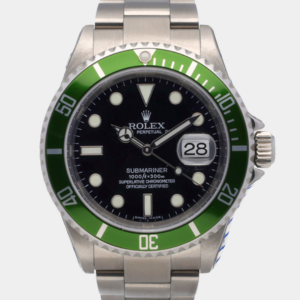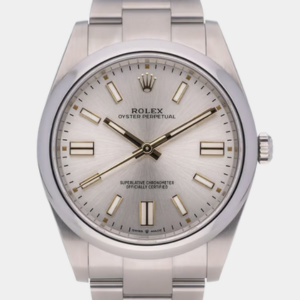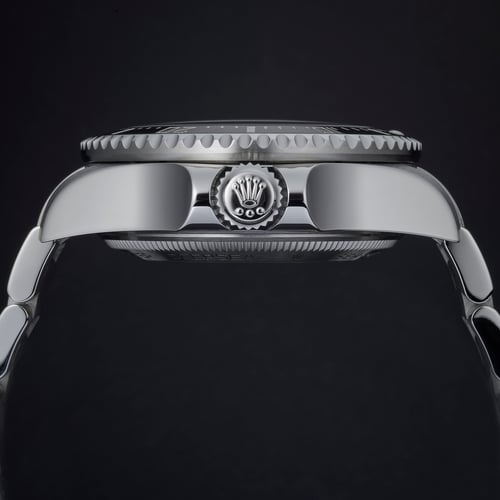If you’ve ever strapped a Rolex to your wrist, chances are you felt something different. Not just the weight of the watch, but the quiet assurance that this is a timepiece built to last. What you might not know is that much of that durability, much of that silent confidence, comes down to one key element: the Oyster case.
At first glance, it might seem like a simple metal shell - strong, elegant, unmistakably Rolex. But the Oyster case is more than that. It’s a design that rewrote the rules of watchmaking and remains the backbone of every serious Rolex to this day.

Let’s rewind to 1926. At the time, most wristwatches were fragile little things, prone to dust, moisture, and the general wear-and-tear of daily life. Then came Rolex, a relatively young brand with big ideas, led by Hans Wilsdorf - a watchmaker who valued function as much as form. He wanted to make watches that could take a beating and keep ticking.
His answer? The Oyster case - the world’s first waterproof wristwatch case. It was revolutionary. A tightly sealed case, screwed down at the back and topped with a screw-down crown and bezel. The movement inside was hermetically protected from water, dust, and anything else the world could throw at it.
To prove it worked, Rolex famously equipped English swimmer Mercedes Gleitze with an Oyster when she swam the English Channel. The watch emerged unscathed. So did the brand’s reputation.
We live in an era where everything is marketed as “rugged” or “built to last.” But the Rolex Oyster case doesn’t need to shout. It has nearly a century of proof.
Today, every Oyster case is machined from a solid block of metal - Oystersteel, gold, or platinum. No seams, no shortcuts. Just one piece of perfectly honed metal forming the middle case. This isn’t about overengineering for the sake of it. It’s about resilience. That seamless body is tougher, more corrosion-resistant, and helps create a water-tight chamber that protects the movement inside.
Then there’s the case back. Screwed down with Rolex’s proprietary tools at their Geneva workshops, it forms a second layer of defense. Add to that the Twinlock or Triplock crown (depending on the model), and you’ve got a watch that laughs in the face of water damage.
Even if you never dive deeper than the office coffee machine, there’s something deeply reassuring about knowing your watch could take on the ocean - and win.


The brilliance of the Oyster case isn’t just its toughness. It’s how Rolex made durability look so damn good. These aren’t chunky tool watches begging for attention. They’re sleek, balanced, and refined - fit for both the cockpit of a yacht and the corner table at the latest hot restaurant.
Take the Datejust. It might be the definitive everyday Rolex, but it’s built like a fortress. Or the Submariner - a watch born for divers, now equally at home beneath a dinner cuff. That’s the genius of the Oyster case: it underpins everything without making a fuss.
This isn’t about flash. It’s about form meeting function in a way that feels timeless.
While the core essence of the Oyster remains unchanged, Rolex has continually refined its design over the years. Throughout its history, the brand has quietly introduced innovations that have further enhanced the durability and performance of its iconic watch case.
One significant milestone came in the 1950s with the introduction of the Triplock crown, distinguished by its three dots. This innovation revolutionized waterproofing in Rolex's professional diving watches, offering unmatched reliability even at great depths.
In more recent times, Rolex has embraced advanced materials like Cerachrom, a scratch-resistant ceramic used in bezels, and Everose gold, their exclusive pink gold alloy. These materials not only enhance the watch's resilience against wear and tear but also contribute to its exquisite aesthetic appeal.
Moreover, every modern Rolex case undergoes rigorous testing in Rolex's own laboratories. Each watch is pressure-tested beyond its rated depth, ensuring it exceeds expectations for durability and performance. This commitment to quality is why a Rolex not only survives but thrives in the most challenging environments, earning the trust of enthusiasts and professionals alike worldwide.

The Oyster case has housed some of the most legendary watches in horological history.
Submariner – The ultimate tool watch. Born in 1953, its Oyster case made it the go-to for divers long before luxury collectors took notice.
GMT-Master – Originally designed for Pan Am pilots, this dual-timezone watch became a jet-set icon, its Oyster case shielding it through decades of wear.
Daytona– A racing chronograph that’s now one of the most sought-after watches on the planet. Beneath the glitz and hype, it’s still anchored by the same bulletproof case design.
The Oyster case isn’t flashy. It doesn’t get much attention compared to bezel colors or dial designs. But it’s the reason Rolex watches last as long as they do. It’s the core design that made waterproof watches a standard in the industry. And nearly a century after its invention, Rolex still builds every Oyster model around the same principle: protect the movement at all costs.
For anyone serious about buying a watch that does more than just look good, that kind of reliability matters.
At BQ Watches, we can help you chose the perfect Rolex with an Oyster case. If you don’t spot your ideal timepiece in our current inventory, don’t hesitate to reach out to our team. With our extensive sourcing services, we’re dedicated to helping you track down your dream watch.
At BQ Watches, we’re dedicated to helping you find the perfect pre-owned luxury watch. Our curated collection features all the leading brands, available to browse online at your convenience. Prefer a more personal experience? Visit our luxury showroom, where our knowledgeable team will be delighted to guide you in choosing the ideal timepiece.